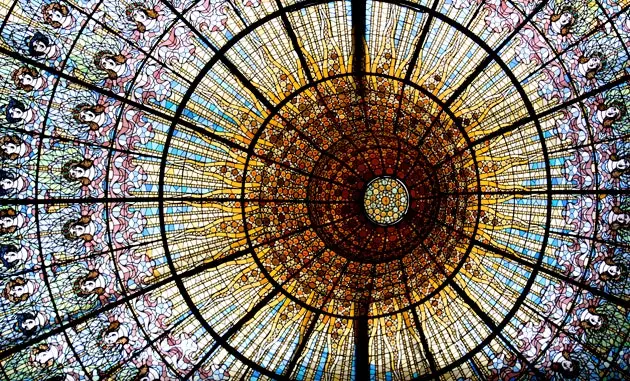
The sun of the Palau de la Música Catalana
Not only from Gaudí lives Barcelona . It is clear that it is his architectural prodigies that dazzled and continue to dazzle the world. Anyone who stands in front of the Casa Batlló, la Pedrera or go up to have a look from Park Güell It suffers from a clear Gaudian Stendhal syndrome, but Barcelona, as far as modernism is concerned, has a lot of things to boast about. We propose an off circuit by motorcycle, a modern modernist route through those other singularities that flooded the city at the beginning of the 20th century and that sometimes they are overshadowed by the teacher, because there were other teachers who also deserve their 15 minutes of fame.
A CITY WITHIN ANOTHER
We start big 'mammodonically' we could say , and we do it for the most important modernist complex in Europe, a World Heritage Site and an indisputable must go: San Pau Modernist Enclosure . Lluis Domènech i Montaner (we learn his name, because he is going to go out a few times) molded a group of buildings to accommodate a hospital, that of the Holy Cross and Saint Paul either. Brick, gothic inspiration and talent came together in this small self-sufficient city, there are 12 buildings that were built under the hygienist standards of the moment.
After an ambitious rehabilitation process, which has valued all its artistic wealth, this architectural complex plunges into the 21st century as a campus of innovation and knowledge, with space in its pavilions for national and international organizations, institutions and companies with projects related to sustainability, health or education. Casa Asia or the European Forest Institute are some of them.
The good news is that now taking a walk along its orderly central promenade is a sensitive gift available to everyone, an aesthetic statement with its symmetrical layout, its colored domes and its saints. Or enter its pavilions, which is like traveling to Willy Wonka's modernist factory, with pistachio and bubblegum pink tiled ceilings that make you want to eat them.
UNIVERSAL STYLE
On the way to Ciutadella Park , under the passeig de Sant Joan with one of the most evocative views of the Barcelona : the Arch of Triumph built by the architect Josep Vilaseca to triumphantly adorn the entrance to the Universal Exposition in Barcelona in 1888. A brick arch, which emerged as a monument to the arts and not to commemorate any victory or battle. Barcelona, how beautiful you are on a motorcycle!
The interior of the park houses what was the official restaurant of the event, the Castell dels Tres Dragons, with battlements, towers and shields with reptiles. Today it is the Nature Laboratory of the Museu de Ciències Naturals de Barcelona, but it was the Museum of History, Archaeology, Municipal School of Music or soup kitchen during the post-war . As a curious fact, the opening of the building did not arrive at the official opening of the Universal Exhibition, causing its architect, our friend Domènech i Montaner, to resign.
WAITING FOR THE MUSES
Els Quatre Gats is a must stop. Santiago Rusiñol, Ramón Casas or Pablo Picass or they showed their tricks to the customers of this mythical restaurant-brewery-café located in a building by Josep Puig i Cadafalch, another of the great Catalan architects of the time. It's almost a museum , with dozens of works hanging on its walls and the spirit of those days at the end of the century. Here a coffee tastes of modernism.
ART FOR THE EARS
When the Orfeó Catalá looked for an architect to give them a home in Barcelona, they wisely chose **Domènech i Montaner to build the Palau de la Música Catalana**. With his unique vision and adapting to a rather meager space, the genius devised a building in brick, stone filigree and ceramics, and with a sculptural representation of the Catalan song as a prow. A large music box whose interior destroyed any previous convention about what a concert hall should be. If we put some tiles in a cocktail shaker, Wagner, the Renaissance, some blown glass, spring, colored tiles, an organ and Catalan music it could only become this unique building, a World Heritage Site.
Light pours in through the large windows of the concert hall, varying its intensity with the hours of the day reaching the colors of the night , a whole spectacle that accompanies the musical appointments that are programmed in it. Classical music, rock and roll, flamenco and even modern dance , everything has a place in this room where those who attend, whether public or artists, agree in defining their experience as magical.
THE ART OF BOOKS
The Antoni Tàpie Foundation s occupies what used to be the offices of the Montaner i Simón publishing house, designed in brick and iron by the work and grace of, once again, Lluis Domènech i Montaner. He devised it for his uncle Ramón Montaner and his partner Francisco Simón in 1881 creating one of the first models of modernism in that part of the expansion. Today the foundation shows great milestones of the work of Tàpies and the private collection that the artist treasured during his life, with pieces by George Braque, Picasso, Goya, Zurbarán or Miró , among others.
A GOLDEN BROOCH
The Apple of Discord, which as in the Greek myth, It costs a thousand to decide who would deserve to win the golden fruit in this small corner of Barcelona , a whole waste of curves and colors. The Casa Lleó Morera, the Amatller or the Batlló (Here we allow Gaudí everything). We were stunned by them, thus concluding a day rich in modernism and knowledge, reviewing the architectural landmarks of Barcelona and the many geniuses, in addition to Antoni Gaudí, who fully contributed to Catalan modernism.
Map: See map
Guy: Interesting place
